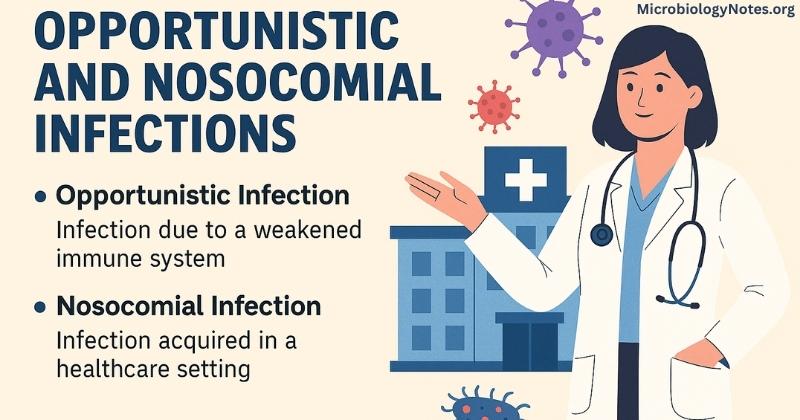Introduction
Nosocomial infections (also known as hospital-acquired infections) and opportunistic infections are two major health threats commonly associated with weakened immune systems or clinical environments. Understanding their sources, types, causes, and prevention is critical in clinical microbiology and patient care.

Nosocomial Infections (Hospital-Acquired Infections)
What Are Nosocomial Infections?
Nosocomial infections are infections that patients acquire during their stay in hospitals, clinics, or other healthcare facilities. These infections can also affect visitors, healthcare workers (doctors, nurses), support staff, delivery personnel, and caregivers. While many infections become clinically evident during hospitalization, some may develop after the patient has been discharged.
Common Nosocomial Pathogens
Most nosocomial infections are caused by opportunistic bacteria and viruses—often part of the patient’s normal flora. Fungi and protozoa are less common culprits.
Sources of Nosocomial Infections
1. Endogenous Sources (Patient's Own Flora)
The patient’s normal microbiota (from the skin, respiratory tract, gastrointestinal tract, or genitourinary system) can cause infections when:
- Surgical or invasive procedures are performed
- The immune system is suppressed
- Antibiotic use disrupts normal microbial balance
Examples:
- E. coli causing urinary tract infections
- Staphylococcus aureus causing wound infections
2. Exogenous Sources (External Environment)
Infections acquired from the hospital environment or equipment such as:
- Contaminated catheters, ventilators, or surgical tools
- Hospital surfaces (bed rails, sinks, door handles)
- Airborne particles (HVAC systems, construction dust)
- Contaminated food or water
Examples:
- Pseudomonas from contaminated water (respiratory infections)
- Acinetobacter from surfaces (bloodstream/wound infections)
3. Cross-Infection (Person-to-Person Transmission)
Transmission can occur through:
- Unwashed hands
- Contaminated gloves or clothing
- Shared hospital equipment or rooms
Examples:
- MRSA (Methicillin-resistant Staphylococcus aureus)
- Clostridioides difficile (C. diff)
4. Environmental Reservoirs
Hospital environment or vectors can also act as reservoirs:
- Airborne (e.g., Mycobacterium tuberculosis)
- Waterborne (Legionella)
- Vector borne (flies, cockroaches)
Control, Prevention, and Surveillance
Control Measures
- Strict hand hygiene practices
- Sterilization of instruments
- Use of personal protective equipment (PPE)
- Isolation protocols for infected patients
- Waste management and surface disinfection
- Formation of infection control committees
Prevention Strategies
- Vaccination of patients and staff
- Antimicrobial stewardship
- Safe catheter and medical device practices
- Patient education on hygiene
- Structural improvements (ventilation, water quality)
Surveillance Systems
- Routine monitoring and microbiological sampling
- Tracking infection rates and antimicrobial resistance
- Reporting mechanisms and outbreak detection
- Evaluation of infection control effectiveness
Opportunistic Infections
What Are Opportunistic Infections?
Opportunistic infections (OIs) occur when pathogens that are normally harmless take advantage of a weakened immune system. These pathogens include viruses, bacteria, protozoa, and fungi.
Types of Opportunistic Infections
Common in HIV/AIDS and other immunocompromised conditions:
- Tuberculosis (TB) – A chronic lung infection caused by Mycobacterium tuberculosis
- Candidiasis – Fungal infection by Candida, affecting mouth, esophagus, or genital areas
- Cytomegalovirus (CMV) – Can lead to pneumonia, retinitis, or gastrointestinal diseases
- Pneumocystis Pneumonia (PCP) – Caused by Pneumocystis jirovecii, affects lungs
- Toxoplasmosis – Caused by Toxoplasma gondii, affects brain, eyes, lungs
- Cryptococcosis – Fungal disease caused by Cryptococcus neoformans
- Cryptosporidiosis – Protozoan infection causing severe diarrhea
- Mycobacterium Avium Complex (MAC) – Causes systemic infection in immunocompromised patients
- Herpes Simplex Virus (HSV) – Reactivation of latent HSV causes painful lesions and esophagitis
Causes of Opportunistic Infections
- HIV/AIDS
- Chemotherapy
- Immunosuppressive drugs (e.g., post-transplant)
- Severe malnutrition
- Prolonged antibiotic use
- Age-related immune decline (infants and elderly)
- Bone marrow disorders
- Pregnancy
- Skin injuries
Signs and Symptoms
Depending on the infected organ system:
- Fever
- Productive cough, shortness of breath
- Oral or vaginal thrush
- Weight loss, fatigue
- Skin rashes, genital sores
- Vision loss, headaches
- Persistent diarrhea
- Difficulty swallowing (dysphagia)
- Pain during swallowing (odynophagia)
Diagnostic Methods for Opportunistic Infections
- CD4 Count: Lower counts (<200 cells/µL) indicate high OI risk
- Chest X-ray: Used for prolonged cough and fever
- Sputum Smear: Microscopic analysis for lung infections
- Serological Tests: ELISA, agglutination, immunofluorescence for pathogen detection
- MRI/CT Scan: Used in patients with neurological symptoms
- Stool Examination: For ova, cysts, and protozoa in diarrhea cases
Conclusion
Understanding the difference between opportunistic and nosocomial infections is crucial for microbiology students, healthcare professionals, and researchers. Effective control and prevention of these infections rely on strict hygiene, surveillance systems, and immune health maintenance.

